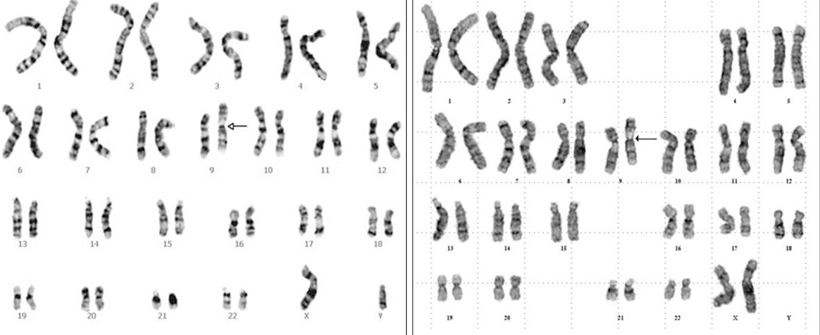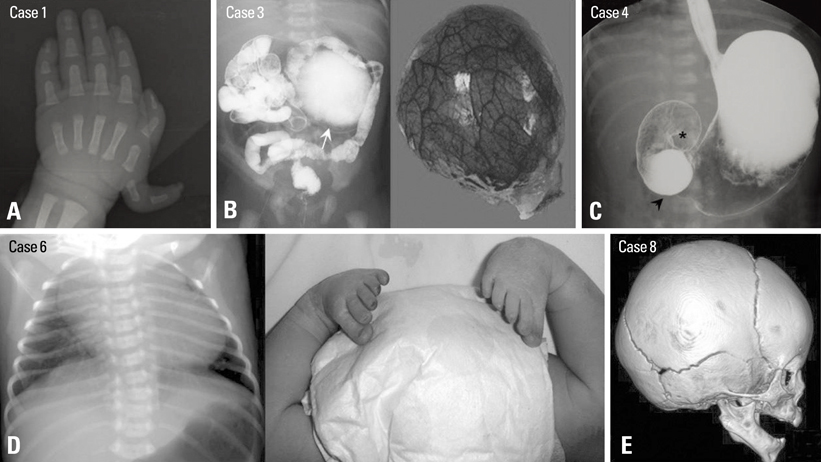Yonsei Med J.
2010 Sep;51(5):775-780. 10.3349/ymj.2010.51.5.775.
De Novo Pericentric Inversion of Chromosome 9 in Congenital Anomaly
- Affiliations
-
- 1Department of Medical Genetics, School of Medicine, Ajou University, Suwon, Korea.
- 2Department of Pediatrics, School of Medicine, Ajou University, Suwon, Korea. jeyumd@ajou.ac.kr
- KMID: 1071432
- DOI: http://doi.org/10.3349/ymj.2010.51.5.775
Abstract
- PURPOSE
The pericentric inversion of chromosome 9 is one of the most common structural balanced chromosomal variations and has been found in both normal populations and patients with various abnormal phenotypes and diseases. The aim of this study was to re-evaluate the clinical impact of inv(9)(p11q13).
MATERIALS AND METHODS
We studied the karyotypes of 431 neonates with congenital anomalies at the Pediatric Clinic in Ajou University Hospital between 2004 and 2008 and retrospectively reviewed their clinical data.
RESULTS
Chromosomal aberrations were detected in 60 patients (13.9%). The most common type of structural abnormality was inv(9)(p11q13), found in eight patients. Clinical investigation revealed that all eight cases with inv(9)(p11q13) had various congenital anomalies including: polydactyly, club foot, microtia, deafness, asymmetric face, giant Meckel's diverticulum, duodenal diaphragm, small bowel malrotation, pulmonary stenosis, cardiomyopathy, arrhythmia, and intrauterine growth restriction. The cytogenetic analysis of parents showed that all of the cases were de novo heterozygous inv(9)(p11q13).
CONCLUSION
Since our results indicate that the incidence of inv(9)(p11q13) in patients with congenital anomalies was not significantly different from the normal population, inv(9)(p11q13) does not appear to be pathogenic with regard to the congenital anomalies. Some other, to date unknown, causes of the anomalies remain to be identified.
Keyword
MeSH Terms
Figure
Reference
-
1. McFadden DE, Friedman JM. Chromosome abnormalities in human beings. Mutat Res. 1997. 396:129–140.
Article2. Jacobs PA, Hassold TJ. Vogel F, Sperling K, editors. Chromosome abnormalities: origin and etiology in abortions and livebirths. Human Genetics. 1987. Berlin: Springer;233–244.
Article3. Hsu LY, Benn PA, Tannenbaum HL, Perlis TE, Carlson AD. Chromosomal polymorphisms of 1, 9, 16, and Y in 4 major ethnic groups: a large prenatal study. Am J Med Genet. 1987. 26:95–101.4. Kaiser P. Pericentric inversions. Problems and significance for clinical genetics. Hum Genet. 1984. 68:1–47.5. Teo SH, Tan M, Knight L, Yeo SH, Ng I. Pericentric inversion 9--incidence and clinical significance. Ann Acad Med Singapore. 1995. 24:302–304.6. Yamada K. Population studies of INV(9) chromosomes in 4,300 Japanese: incidence, sex difference and clinical significance. Jpn J Hum Genet. 1992. 37:293–301.
Article7. Kim JJ, Rhee HS, Chung YT, Park SY, Choi SK. Prenatal detection of de novo inversion of chromosome 9 with duplicated heterochromatic region and postnatal follow-up. Exp Mol Med. 1999. 31:134–136.
Article8. Shaffer LG, Slovak ML, Campbell LJ, editors. ISCN. An International System for Human Cytogenetic Nomenclature, 2009. 2009. Basel: Karger.9. Starke H, Seidel J, Henn W, Reichardt S, Volleth M, Stumm M, et al. Homologous sequences at human chromosome 9 bands p12 and q13-21.1 are involved in different patterns of pericentric rearrangements. Eur J Hum Genet. 2002. 10:790–800.10. Kim SS, Jung SC, Kim HJ, Moon HR, Lee JS. Chromosome abnormalities in a referred population for suspected chromosomal aberrations: a report of 4117 cases. J Korean Med Sci. 1999. 14:373–376.11. Rao BV, Kerketta L, Korgaonkar S, Ghosh K. Pericentric inversion of chromosome 9[inv(9)(p12q13)]: Its association with genetic diseases. Indian J Hum Gent. 2006. 12:129–132.
Article12. Scarinci R, Anichini C, Vivarelli R, Berardi R, Pucci L, Rosaia L, et al. [Correlation of the clinical phenotype with a pericentric inversion of chromosome 9.]. Boll Soc Ital Biol Sper. 1992. 68:175–181.13. Baltaci V, Ors R, Kaya M, Balci S. A case associated with Walker Warburg syndrome phenotype and homozygous pericentric inversion 9: coincidental finding or aetiological factor? Acta Paediatr. 1999. 88:579–583.
Article14. Stanojević M, Stipoljev F, Koprcina B, Kurjak A. Oculo-auriculovertebral (Goldenhar) spectrum associated with pericentric inversion 9: coincidental findings or etiologic factor? J Craniofac Genet Dev Biol. 2000. 20:150–154.15. Salihu HM, Boos R, Tchuinguem G, Schmidt W. Prenatal diagnosis of translocation and a single pericentric inversion 9: the value of fetal ultrasound. J Obstet Gynaecol. 2001. 21:474–477.
Article16. Serra A, Brahe C, Millington-Ward A, Neri G, Tedeschi B, Tassone F, et al. Pericentric inversion of chromosome 9: prevalence in 300 Down syndrome families and molecular studies of nondisjunction. Am J Med Genet. 1990. 7:Suppl. 162–168.
Article17. Demirhan O, Taştemir D. Chromosome aberrations in a schizophrenia population. Schizophr Res. 2003. 65:1–7.
Article18. Uehara S, Akai Y, Takeyama Y, Takabayashi T, Okamura K, Yajima A. Pericentric inversion of chromosome 9 in prenatal diagnosis and infertility. Tohoku J Exp Med. 1992. 166:417–427.
Article19. Kim JW, Lee JY, Hwang JW, Hong KE. Behavioral and developmental characteristics of children with inversion of chromosome 9 in Korea: a preliminary study. Child Psychiatry Hum Dev. 2005. 35:347–357.
Article20. Keung YK, Knovich MA, Powell BL, Buss DH, Pettenati M. Constitutional pericentric inversion of chromosome 9 and acute leukemia. Cancer Genet Cytogenet. 2003. 145:82–85.21. Yasuhara T, Okamoto A, Kitagawa T, Nikaido T, Yoshimura T, Yanaihara N, et al. FGF7-like gene is associated with pericentric inversion of chromosome 9, and FGF7 is involved in the development of ovarian cancer. Int J Oncol. 2005. 26:1209–1216.
- Full Text Links
- Actions
-
Cited
- CITED
-
- Close
- Share
- Similar articles
-
- Prenatal detection of de novo inversion of chromosome 9 with duplicated heterochromatic region and postnatal follow-up
- Incidence and Karyotypes According to Each Chromosome in 13 Cases with Inversion
- A Case of Pericentric Inversion of Chromosome 5(p15.1q11.2 )
- Familial Chromosome No. 9 Pericentic Inversion Producing Scimitar Syndrome
- A Case of Trisomy 10p with Vertebral Anomaly and Hypospadias



